Pav Bhaji is an extremely popular street food from Mumbai. In this vibrant dish, a flavorful mashed vegetable curry, called Bhaji, is enjoyed with warm butter-toasted dinner rolls called Pav. Try this easy 30-minute recipe in your Instant pot or stove, and enjoy the authentic flavors of Mumbai!
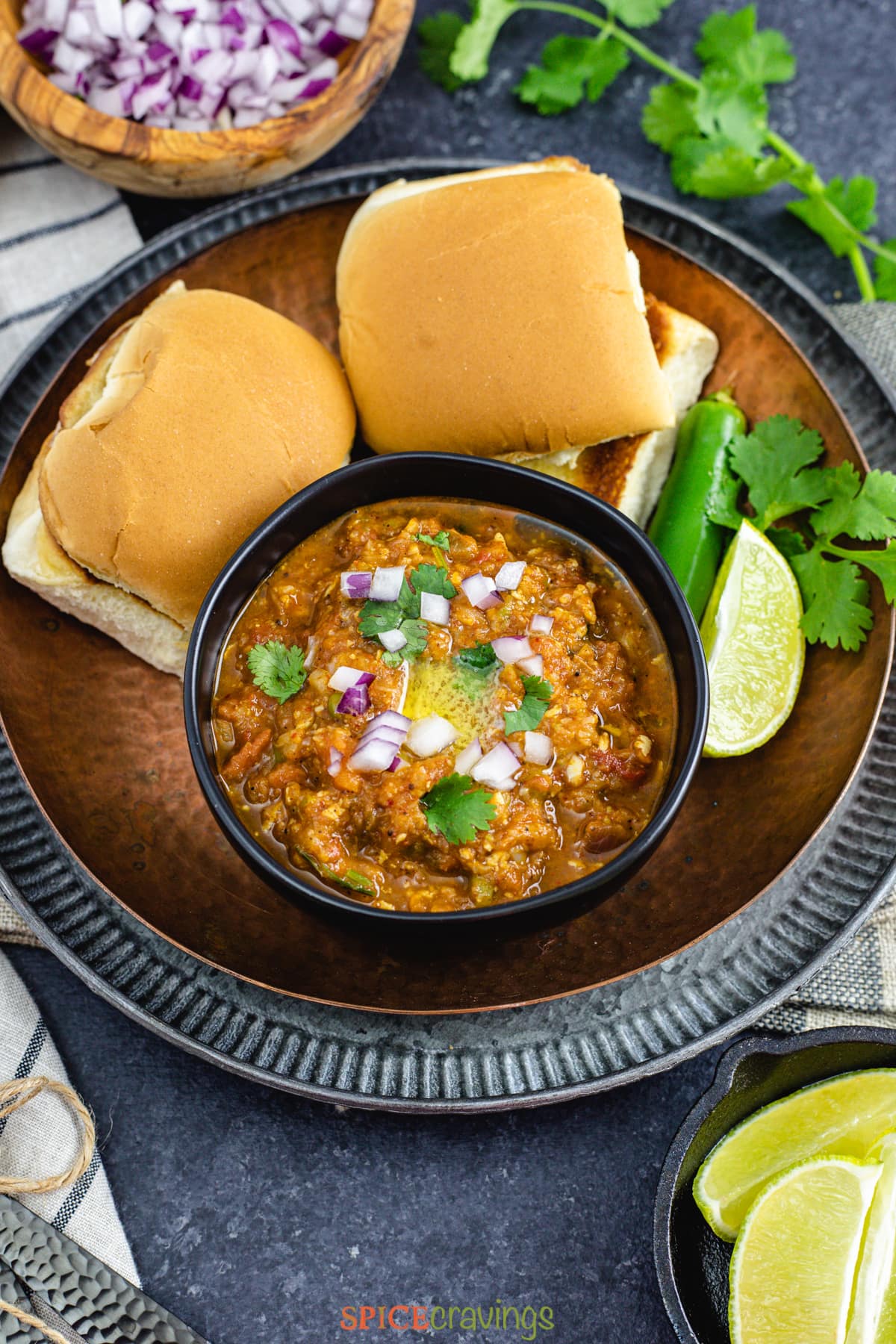
I got introduced to Pav Bhaji during my stay in Mumbai years ago. Since I was homesick, a friend took me out for dinner to cheer me up. We landed at the famous restaurant, 'Shiv Sagar'.
She ordered a Pav Bhaji along with Sitafal (custard apple) milkshake for me. The spicy, flavorful curry scooped with buttery soft buns... it was love at first bite for me!
Today I'm sharing this heartwarming recipe with you all!
Jump to:
- What is Pav Bhaji?
- Pav Bhaji Masala
- Ingredients- Notes & Alternatives
- How to Make Pav Bhaji
- Stovetop Instructions
- Try a Variation: Paneer Pav Bhaji
- How to Make a Low Carb Pav Bhaji
- Serving Suggestions- What bread goes best with bhaji?
- Recipe Tips & Notes
- Frequently Asked Questions
- More Indian Street Food Recipes
- 📖 Recipe
What is Pav Bhaji?
This humble street food comes from the western food hub of India, Mumbai. In this simple dish, a mashed vegetable curry, called Bhaji, is cooked in butter and spiced with a unique spice blend, then served with warm butter-toasted dinner rolls called Pav.
A generous topping of butter, chopped onion, cilantro, and a squeeze of lime is all you need to complete this dish and enjoy an authentic Mumbai-style Pav Bhaji.
Origins of Pav Bhaji: Did you know that pav bhaji originated in the 1860s? The American civil war created a shortage of cotton supply, because of which the cotton mills in Bombay (now Mumbai), stepped up production leading to late-night shifts for many workers.
The local food vendors created this vegetable mash. They cooked leftover vegetables with tomatoes, potatoes, and spices, then served it with toasted bread as a way to feed those tired and hungry men after their long shifts. Thus Pav Bhaji was born!
Pav Bhaji Masala
Pav bhaji masala is a unique spice blend that forms the flavor foundation of this curry. Just like Garam masala, it's a ground-up combination of earthy and floral herbs and seeds.
Personally, I love the store-bought spice blends as much as my homemade version. My preferred brands include Everest or MDH. However, if you would like to make it from scratch, here's a recipe for how to make Pav Bhaji masala at home for this quantity:
- 2 teaspoons garam masala
- 1 tablespoon coriander powder
- 1 teaspoon cumin powder
- 2 teaspoons Kashmiri red chili powder
- ½ teaspoon ground fennel
- ½ teaspoon ground green cardamom
Ingredients- Notes & Alternatives
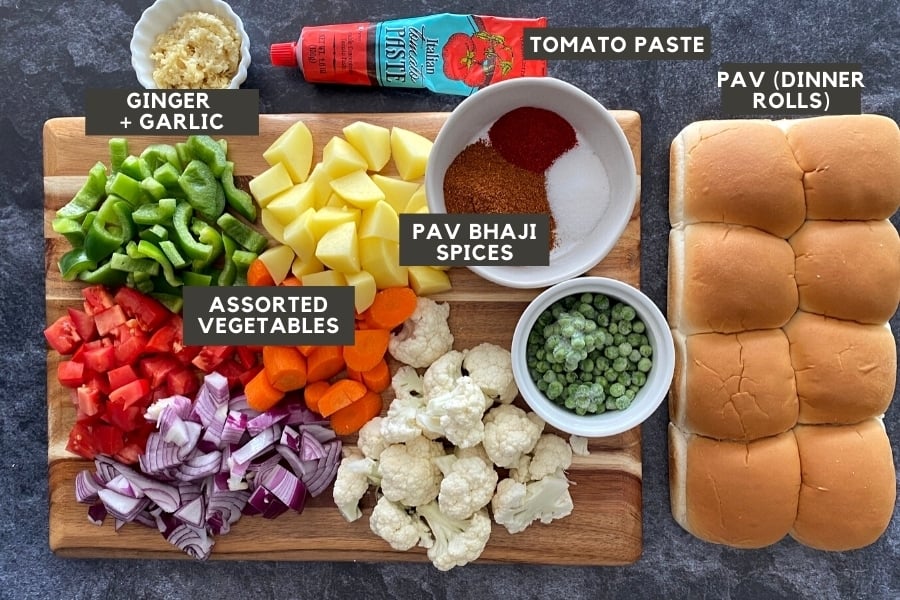
Bhaji and Pav are the two components in this heart-warming meal. Let's see what we need for that:
- Assorted Vegetables: I this recipe, I stick to the traditional assortment of vegetables, including cauliflower, peppers, potatoes, carrots and peas. But you can add any mix you like, just keep the total at 7 to 8 cups of chopped vegetables. Fresh vegetables give the best result here (except peas).
- Pav Bhaji Masala: Like discussed above, I prefer Everest or MDH Pav Bhaji masala, but you can certainly make your own following the recipe above.
- Aromatics: Onion, ginger and garlic give this curry a flavorful foundation. Use fresh or frozen minced ginger and garlic for best results. I prefer that over the jarred products.
- Butter: For an authentic taste, don't skimp on the butter. I prefer to use 'salted butter' in this recipe. It just adds a touch more saltiness which really elevates this curry.
- Pav: You can use any regular dinner rolls, white or wheat, or even burger buns that are't sweet.
- Toppings: Butter, chopped onion and cilantro and fresh lime are the traditional toppings that really complete this dish and add to the flavor and texture of pav bhaji.
Optional ingredient- Paneer: This is optional and entirely a personal preference. A tiny quantity of grated paneer boosts the protein in this dish, making it more wholesome and balanced.
Grating the paneer is key here since the paneer literally melts away in the curry as it cooks, making it creamier and richer. But, feel free to skip it if you want to keep it authentic.
How to Make Pav Bhaji
- Preheat the Instant Pot by selecting Sauté. When the inner pot is hot, add butter and oil. (pic 1)
- When the butter melts, add onions and bell pepper, garlic, and ginger, and saute for 2 minutes. (pic 2)
- Add tomatoes, tomato paste, spices and ¼ cup water. Stir until everything is combined. (pic 3)
- Turn off Sauté. Add vegetables and toss until coated in the spice mix. Add water. (pic 4)
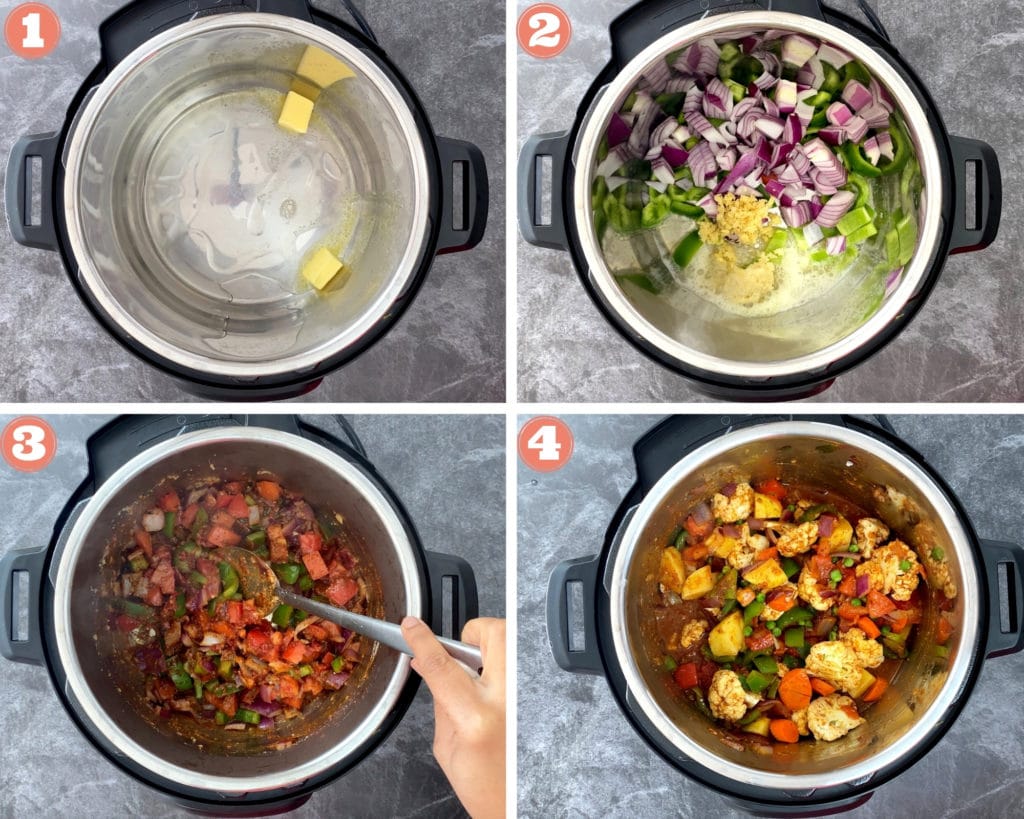
- Close the lid, vent set to sealing mode. Select Manual or Pressure Cook and cook for 8 minutes on high pressure. When the cooking is complete, follow the quick release method as per your cooker instructions to release the pressure. Open the lid after the pin drops. (pic 5)
- Using a potato masher, mash the vegetables until they reach your preferred consistency of a thick curry. Stir in lemon juice and adjust seasoning. Note: If adding grated paneer, stir it in now and let it simmer for 2 minutes. (pic 6 & 7)
- To toast the pav, heat a non-stick pan on medium-high heat. Generously spread butter on both sides of the pav and toast them, butter side down for about a minute on each side.
- Serve the curry warm, topped with a dollop of butter, chopped onion, and cilantro, alongside butter-toasted dinner rolls. (pic 8)
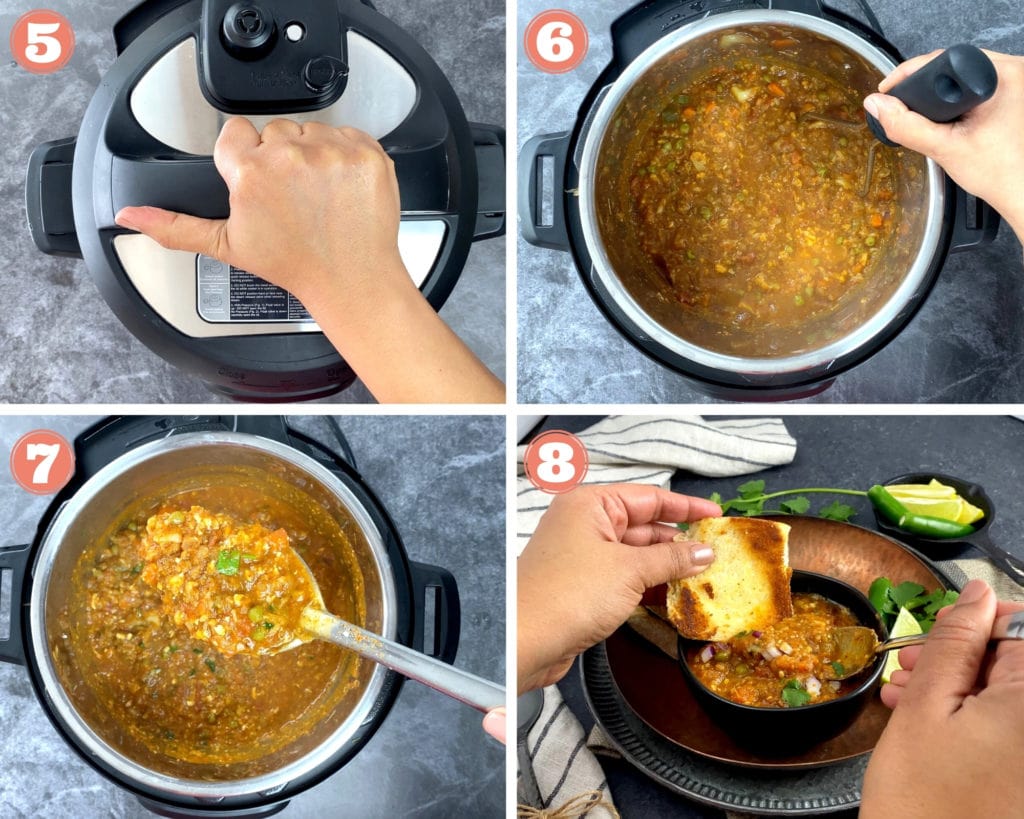
Stovetop Instructions
- Heat a heavy bottom pot on medium-high heat. Follow steps 1 to 4 and saute aromatics, add spices and vegetables.
- Add 2 cups of water and bring it to a simmer. Reduce the heat to medium, cover and cook for 15 to 20 minutes, or until the vegetables are fork tender. Stir 2-3 times in between to prevent burning.
- Using a potato masher, mash the vegetables to the consistency of your liking, and continue to simmer till it thickens.
- Follow the instructions to toast buns and serve with the suggested toppings.
How to Make Pav Bhaji in a Stovetop Pressure Cooker?
Follow the same instructions for sauteing and adding vegetables and water to the pressure cooker. Close the lid and cook on high heat until it whistles 2 times. Reduce the heat to medium and cook for another 5 minutes.
Let the pressure release naturally for 5 minutes. Then, using a wooden spoon carefully release the pressure manually. Open the lid after the pressure is released, then follow instructions for finishing and serving.
Try a Variation: Paneer Pav Bhaji
Stir in grated paneer after pressure cooking and simmer it for 2 to 3 minutes. Paneer adds protein to the dish, making it more balanced, and also makes the curry more rich and creamy. To grate the paneer, use the large holes on the box grater.
How to Make a Low Carb Pav Bhaji
My husband and I love pav bhaji, but when the girls aren't home, we prefer to make it low-carb for both of us. To do that, I skip the potatoes in the bhaji for pav and double up the cauliflower.
As for pav, we toast our preferred keto bread from Costco or Whole Foods and serve it alongside.
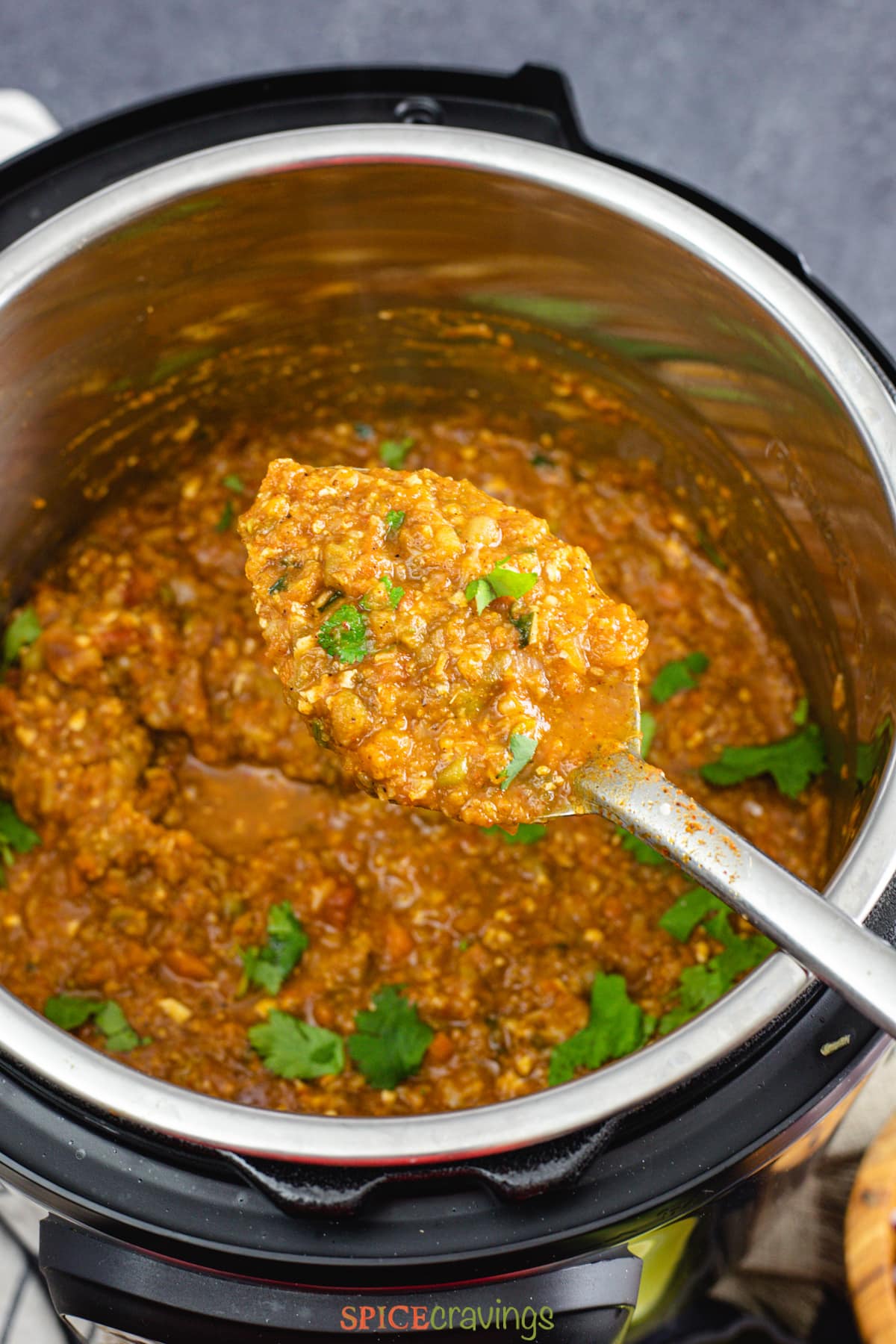
Serving Suggestions- What bread goes best with bhaji?
This vegetable curry is always served with dinner rolls that are toasted in a skillet using a generous amount of butter. For an authentic taste, you can get fresh Pav available at most Indian grocery stores.
Alternatively, feel free to use white or whole-grain dinner rolls that aren't sweet. Burger buns also make a great alternative here.
Other must-have condiments include finely chopped onion, a tiny dollop of butter on the Bhaji (vegetable curry), and freshly squeezed lime just before eating.
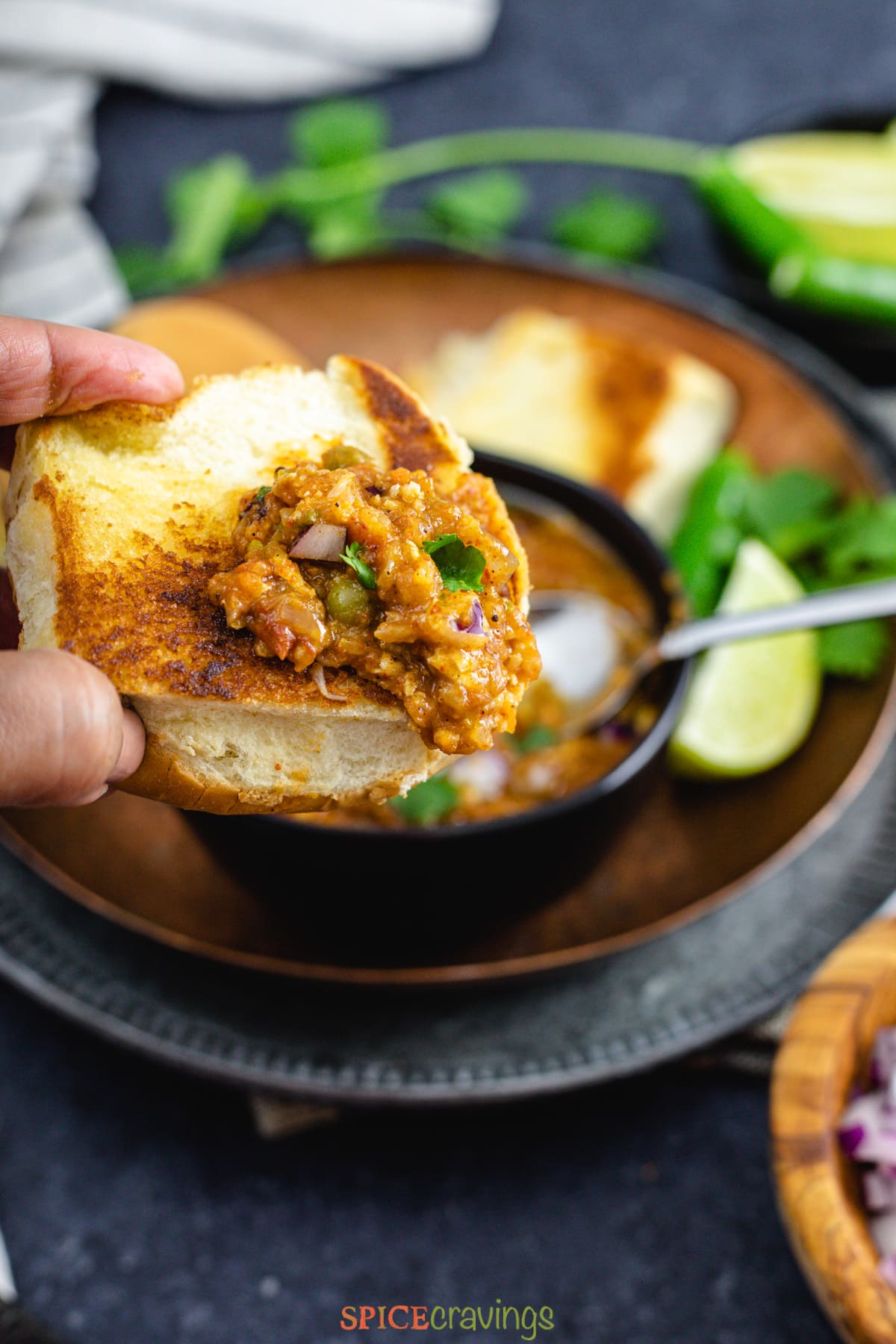
Recipe Tips & Notes
- Vegetables: You can customize the assortment of vegetables in this curry. Be sure to use a total of 7 to 8 cups for this quantity.
- Pav Bhaji Masala: I prefer Everest or MDH brand, it tastes as good as the homemade version. For the homemade recipe, refer to the recipe in the content above.
- Bhaji Consistency: The consistency of Bhaji can be customized to personal preference. My family likes the curry to have more texture, so I mash it using a potato masher. That leaves some chunks in there. For a more mashed-potato-like consistency, you can use your immersion blender. Simply blend the curry a few times, for 2 to 3 seconds each time, until you reach your desired consistency.
- Pav: Any soft dinner rolls or burger buns that aren't sweet will work for this recipe.
- Low Carb Variation: I skip the potatoes in this recipe and double up the cauliflower. As for pav, I toast my favorite keto bread from Costco or Whole Foods.
- Add protein: To add a protein boost to this recipe without altering flavors, stir in 2 oz. of grated paneer after pressure cooking and simmer for a few minutes.
Frequently Asked Questions
I prefer to use Everest brand or MDH, but I have also listed the homemade recipe in the content above.
This dish is around 200 calories per serving and is heavy on carbs with approximately 26 grams of net carbs per serving. You can reduce the calories by eliminating or reducing the butter and potatoes. I have also listed a lower-carb variation of this recipe in the content above.
The cooking time remains the same even if you double this recipe. The Instant Pot adjusts and takes a bit longer to come to pressure though, which increases your total time.
That totally depends on the texture you like. Traditionally, a potato masher is used to leave some texture in the curry. But if you like it more pureed than chunky, you can use an immersion blender and blend for 2-3 seconds a few times to reach your desired consistency.
More Indian Street Food Recipes
- Bombay Masala Toast
- Matar Chaat with Kulcha
- Dahi Bhalla Chaat
- Paneer Kathi Roll
- Chicken Kathi Roll
- Punjabi Chole with Bhature
- Dhaba Style Keema
- Steamed Idli with Coconut Chutney
- Ginger Tea (Adrak Chai)
★ Did you make this recipe? Please give it a star rating below! For more quick & easy recipes, FOLLOW ME on Facebook, Instagram, Pinterest and Youtube.
📖 Recipe
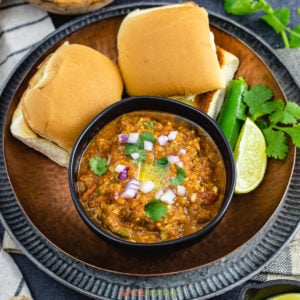
Pav Bhaji
Equipment
Ingredients
- 1 tablespoon butter
- 1 tablespoon olive oil
- 1 medium onion chopped ( 1 cup)
- 1 cup green bell pepper diced
- 1 tablespoon minced ginger
- 1 tablespoon minced garlic
- 2 roma tomatoes chopped
- 2 tablespoons tomato paste
- 1 cup carrots chopped in ½-inch pieces
- 3 cups cubed gold potatoes ½-inch pieces
- 2 cups cauliflower florets
- ½ cup green peas frozen or fresh
- 2½ tablespoons pav bhaji masala
- 1 teaspoon kashmiri red chili powder
- 2 teaspoon salt
- 1 cup water
For Finishing
- ¼ cup finely chopped onion
- ¼ cup chopped cilantro
- Juice of ½ lemon
- 2 oz grated paneer (optional)
Instructions
- Preheat the Instant Pot by selecting Sauté. When the inner pot is hot, add butter and oil. When the butter melts, add onions and bell pepper, and saute for 2 minutes. garlic, and ginger, and cook for 2 minutes. Add minced ginger and garlic and saute for another minute.
- Add tomatoes, tomato paste, spices and ¼ cup water. Stir until everything is combined.
- Turn off Sauté. Add vegetables and toss until coated in the spice mix. Add water.
- Close the lid, vent set to sealing mode. Select Manual or Pressure Cook and cook for 8 minutes on high pressure. When the cooking is complete, follow the quick release method as per your cooker instructions to release the pressure. Open the lid after the pin drops.
- Using a potato masher, mash the vegetables until they reach your preferred consistency of a thick curry. Stir in lemon juice and adjust seasoning.
- To toast the pav, heat a non-stick pan on medium-high heat. Generously spread butter on both sides of the pav and toast them, butter side down. Serve the Bhaji warm, topped with a dollop of butter, chopped onion, and cilantro, with butter-toasted pav (dinner rolls).
Optional Step
- Optionally, grate paneer and stir it in the curry to add some protein.
Video
Notes
- Vegetables: You can customize the assortment of vegetables in this curry. Be sure to use a total of 7 to 8 cups for this quantity.
- Pav Bhaji Masala: I prefer Everest or MDH brand, it tastes as good as the homemade version. It is easily available in Indian grocery stores or online. For the homemade recipe, refer to the recipe in the content above.
- Bhaji Consistency: The consistency of Bhaji can be customized to personal preference. My family likes the curry to have more texture, so I mash it using a potato masher. That leaves some chunks in there. For a more mashed-potato-like consistency, you can use your immersion blender. Simply blend the curry a few times, for 2 to 3 seconds each time, until you reach your desired consistency.
- Pav: Any soft dinner rolls or burger buns that aren't sweet will work for this recipe.
- Low Carb Variation: I skip the potatoes in this recipe and double up the cauliflower. As for pav, I toast my favorite keto bread from Costco or Whole Foods.
- Add protein: To add a protein boost to this recipe without altering flavors, stir in 2 oz. of grated or chopped paneer (¼-inch pieces) after pressure cooking and simmer for a few minutes.



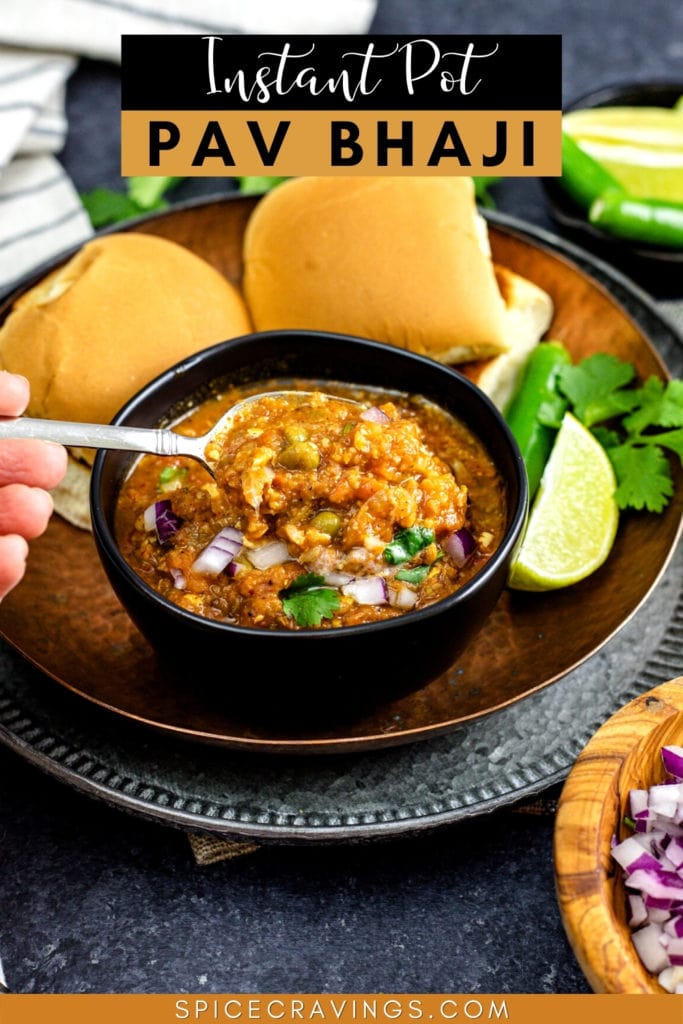
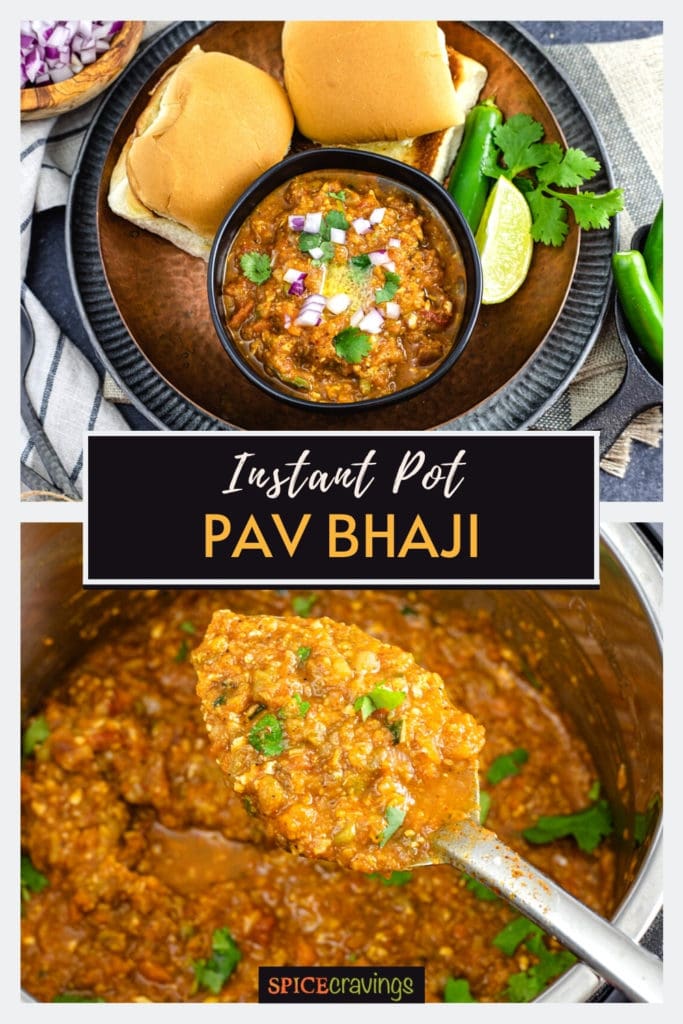

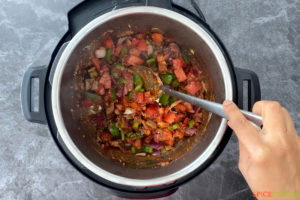
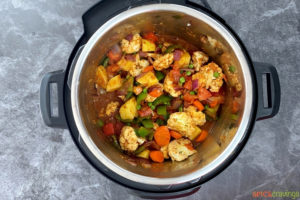
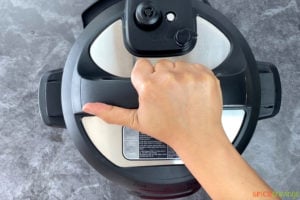
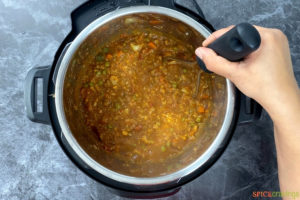
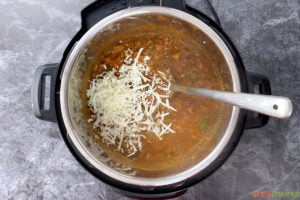
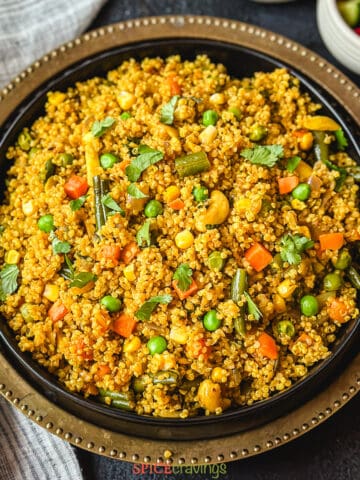
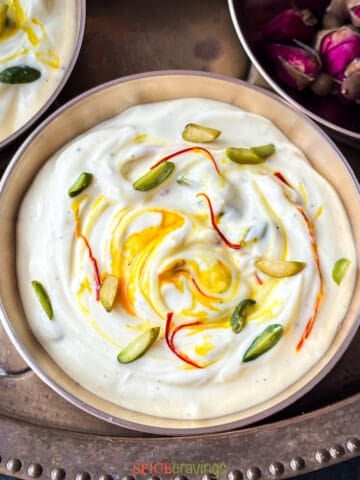
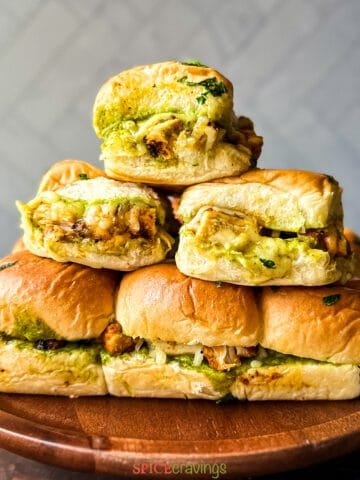
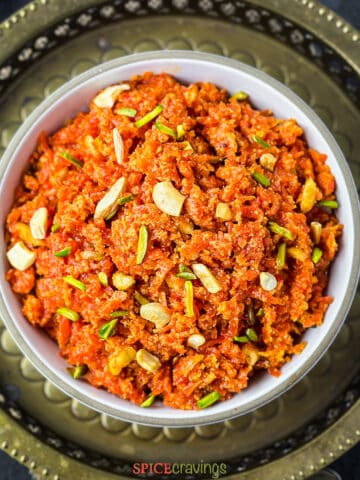

Anu says
Is it made in 3 quart or 6 quart instant pot?
Aneesha says
Hi Anu, this quantity can be made in either. Just make sure that your ingredients don't exceed the max line in the steel insert. Enjoy!
Dak says
The spices elevated a mash of common vegetables to something absolutely wonderful. So glad I ordered the Kashmiri red chili powder, it took a while to reach here from India (via your Amazon link) but well worth the wait, it adds a unique heat to the dish.
Aneesha says
Hi Dak, thank you! I'm so glad you enjoyed this dish! Now that you have that gorgeous spice, hope you try more recipes with it!
Manisha says
I was hoping you’d put this recipe up one of these days and boy was the wait worth it. Simply delicious, thank you!
Aneesha says
Hi Manisha, Wow, I'm super glad you enjoyed it, thank you! And you're always welcome to send recipe requests to me via comments on the blog or social media.